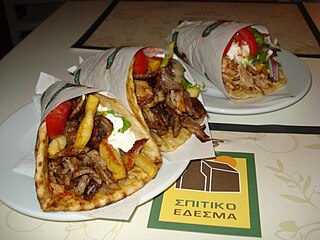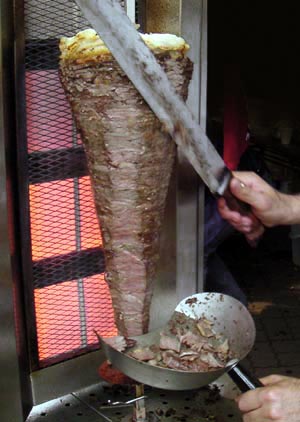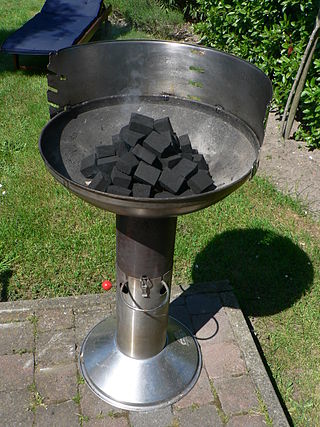
İskender kebap is a Turkish dish that consists of sliced döner kebab meat topped with hot tomato sauce over pieces of pita bread, and generously slathered with melted special sheep's milk butter and yogurt. It can be prepared from thinly cut grilled lamb or chicken. Tomato sauce and melted butter are generally poured over the dish live at the table, for the customer's amusement.

Turkish cuisine is the cuisine of Turkey and the Turkish diaspora. Although the cuisine took its current rich form after numerous cultural interactions throughout centuries, it should not be confused with other cuisines such as Ottoman cuisine or Seljuk cuisine. Turkish cuisine with traditional Turkic elements such as yogurt, ayran, kaymak, exerts and gains influences to and from Mediterranean, Balkan, Middle Eastern, Central Asian and Eastern European cuisines.

Gyros, sometimes anglicized as a gyro in some regions, is meat cooked on a vertical rotisserie, then sliced and served wrapped or stuffed in pita bread, along with other ingredients such as tomato, onion, fried potatoes, and tzatziki. In Greece, it is normally made with pork or sometimes with chicken, whilst beef and lamb are also used in other countries.

Kebab, kabob, kebap, or kabab (Kashmir) is roasted meat that originates from the Middle East. Many variants of the category are popular around the world, including the skewered shish kebab and the doner kebab with bread.

Shawarma is a Middle Eastern dish that originated in the Levant region of the Arab world during the Ottoman Empire, consisting of meat that is cut into thin slices, stacked in an inverted cone, and roasted on a slow-turning vertical spit. Traditionally made with lamb or mutton, it may also be made with chicken, turkey, beef, or veal. The surface of the rotisserie meat is routinely shaved off once it cooks and is ready to be served. Shawarma is a popular street food throughout the Arab world and the Greater Middle East.

Doner kebab, also spelled as döner kebab, is a dish of Turkish origin made of meat cooked on a vertical rotisserie. Seasoned meat stacked in the shape of an inverted cone is turned slowly on the rotisserie, next to a vertical cooking element. The operator uses a knife to slice thin shavings from the outer layer of the meat as it cooks. The vertical rotisserie was invented in the 19th-century Ottoman Empire, and dishes such as the Arab shawarma, Greek gyros, Canadian donair, and Mexican al pastor are derived from this.

Ćevapi or ćevapčići is a grilled dish of minced meat found traditionally in the countries of southeast Europe. It is considered a national dish of Bosnia and Herzegovina and Serbia, with Bosnia and Herzegovina taking steps in branding and placing them on the list of intangible heritage, with a nomination for inclusion on the UNESCO List of Intangible Cultural Heritage. Ćevapi are also common in Albania, Bulgaria, Croatia, Kosovo, Montenegro, North Macedonia, and Slovenia.

A wrap is a culinary dish made with a soft flatbread rolled around a filling.

Adana kebab is a dish that consists of long, hand-minced meat. Mounted on a wide iron skewer and grilled on an open mangal filled with burning charcoal. The culinary item is named after Adana, the fifth-largest city of Turkey and was originally known as the kıyma kebabı or kıyma in Adana-Mersin and the southeastern provinces of Turkey.

Barbecue varies by the type of meat, sauce, rub, or other flavorings used, the point in barbecuing at which they are added, the role smoke plays, the equipment and fuel used, cooking temperature, and cooking time.

Shish kofta (Turkish) is a type of kebab-style kofta dish in Turkish cuisine.

Afghan cuisine is influenced to a certain extent by Persian, Central Asian and Indian cuisines due to Afghanistan's close proximity and cultural ties. The cuisine is halal and mainly based on mutton, beef, poultry and fish with rice and Afghan bread. Accompanying these are common vegetables and dairy products, such as milk, yogurt, and whey, and fresh and dried fruits such as apples, apricots, grapes, bananas, oranges, plums, pomegranates, sweet melons, and raisins. The diet of most Afghans revolves around rice-based dishes, while various forms of naan are consumed with most meals. Tea is generally consumed daily in large quantities, and is a major part of hospitality. The culinary specialties reflect the nation's ethnic and geographic diversity. The national dish of Afghanistan is Kabuli palaw, a rice dish cooked with raisins, carrots, nuts, and lamb or beef.
Beyti is a restaurant in Istanbul, Turkey specialising in roasted meat. It was founded in 1945 in Küçükçekmece and since 1983 has been situated in Florya. The establishment is owned by the restaurateur Beyti Güler and run by him together with his sons Cüneyt and Ahmet.

Meat plays a much more dominant role in Pakistani cuisine, compared to other South Asian cuisines. Of all the meats, the most popular are chicken, lamb, beef, goat, and fish. Beef is particularly sought after as the meat of choice for kebab dishes or the classic beef shank dish nihari. Seafood is generally not consumed in large amounts, though it is very popular in the coastal areas of Sindh and the Makran coast of Balochistan.
Kadir Nurman was a Turkish restaurateur, widely credited with having in 1972, in West Berlin, introduced or "invented" the fast food sandwich commonly known as the "kebab", consisting of traditional Turkish döner kebab meat stuffed together with mixed salad into a flatbread. Nurman received a lifetime achievement award from the Association of Turkish Döner Manufacturers in 2011. Afterwards, Nurman told the German magazine Frankfurter Rundschau that he was unhappy with modern döner kebab sandwiches, as "there are too many ingredients" in them.













